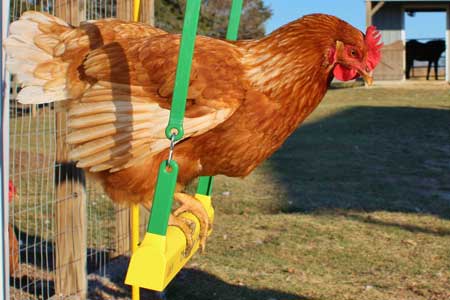
In past blogs we’ve looked at different forms of cannibalism and the causes of cannibalism. But, despite your best efforts, your chickens persist in pecking one another. So let’s take a look at how to control cannibalism in chickens once it gets started.
Identify the Perp
At the first sign of picking, remove the injured bird(s). If possible, house the bird nearby, where it can see the rest of the flock without being bullied while it heals.
Then try to identify and remove the instigator(s). If you can’t catch them in the act, look for birds with blood on their beaks and face feathers. If the perp is an egg eater, look for the one with yolk smeared on its beak and face. Since chickens learn from one another, separating the perpetrator is an essential step.
Alter Coop Lighting
Switch brooder or coop lights to red light bulbs. If bright sunlight comes through a window, cover the pane with clear red plastic (imitation stained glass). Red lighting gives everything a rosy hue, making bloody sores more difficult for chickens to identify.
Another option is to change bright light bulbs to dimmer lights. A good guideline for dimming the lights is to provide just enough light so you can barely read a newspaper.
In hot weather, open windows or turn on a fan to stir the air and reduce the temperature inside the coop. Like people, chickens get irritable when they’re too hot.
Boredom Busters
Alleviate boredom by feeding your flock less at a time and feeding more often. Or by letting chickens spend time outdoors, where they will keep busy exploring and finding things to peck besides each other.
Provide toys such as shiny aluminum pie tins attached to the wall at head height for them to peck at. Or install chicken swings for them to play on. Straw bales give chickens something interesting to explore, and they attracts insects for the chickens to peck at. A treat toy also provides opportunities for pecking.
Feed Considerations
Feather-pulling chickens that subsequently eat the feathers quite likely are seeking needed fiber. Providing pasture forage is an easy way to solve that problem. Oats are another good source of fiber.
Most of a chicken’s body sodium is in its blood. Salt deficiency therefore can cause chickens to crave blood. Resolve this issue by adding 1 tablespoon of salt per gallon of water in the drinker for one morning. Repeat the salt treatment 3 days later. At all other times provide plenty of fresh, unsalted water.
Feed a portion of the flock’s ration as grains, table scraps, or garden greens scattered around the yard. That gives chickens something to hunt and peck besides each other.
Prevention Works Best
Pine tar and various other preparations — such as Blu-Kote, Hot Pick, or Pick-No-More — work for a short time, especially when picking first starts. Also you need to reapply them often. None of them works really well after picking has become serious.
Blinders, specs, or so-called peepers prevent or control cannibalism by keeping chickens from seeing directly ahead to aim a peck. The chief disadvantage to using specs, aside from their looking ridiculous, is that they can lead to eye disorders.
No measure for how to control cannibalism in chickens will work until the conditions that led to the problem are first eliminated. And no attempt to stop cannibalism once it starts is as effective as managing your flock to prevent the problem from getting started in the first place.
And that’s today’s news from the Cackle Coop.
Gail Damerow is author of The Chicken Health Handbook.


Thank you so much for this passage because I am new to taking care of farm animals and this is a ton of help, Thanks again.